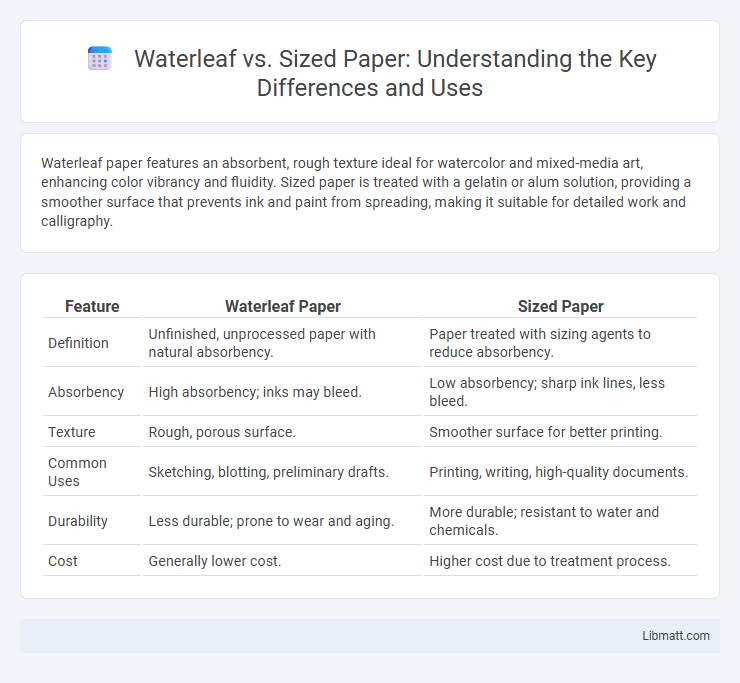Waterleaf paper features an absorbent, rough texture ideal for watercolor and mixed-media art, enhancing color vibrancy and fluidity. Sized paper is treated with a gelatin or alum solution, providing a smoother surface that prevents ink and paint from spreading, making it suitable for detailed work and calligraphy.
Table of Comparison
| Feature | Waterleaf Paper | Sized Paper |
|---|---|---|
| Definition | Unfinished, unprocessed paper with natural absorbency. | Paper treated with sizing agents to reduce absorbency. |
| Absorbency | High absorbency; inks may bleed. | Low absorbency; sharp ink lines, less bleed. |
| Texture | Rough, porous surface. | Smoother surface for better printing. |
| Common Uses | Sketching, blotting, preliminary drafts. | Printing, writing, high-quality documents. |
| Durability | Less durable; prone to wear and aging. | More durable; resistant to water and chemicals. |
| Cost | Generally lower cost. | Higher cost due to treatment process. |
Introduction to Waterleaf and Sized Paper
Waterleaf and sized paper differ primarily in their manufacturing processes, with waterleaf paper being handmade and uncoated, allowing it to absorb ink naturally, while sized paper undergoes treatment with sizing agents to create a smooth surface that resists ink penetration. Waterleaf paper offers a textured, organic feel ideal for calligraphy and archival use, whereas sized paper provides durability and uniformity suitable for writing, printing, and artwork. Understanding these characteristics helps you choose the right paper for your specific artistic or writing needs.
What is Waterleaf Paper?
Waterleaf paper is an ultra-thin, translucent paper known for its delicate texture and high absorbency, commonly used in bookbinding, art, and archival projects. This paper contrasts with sized paper, which is treated with sizing agents to reduce absorbency and increase durability, making it more resistant to ink bleeding and moisture. You can choose Waterleaf paper when a lightweight, fine, and natural look is essential for your creative or restoration work.
What is Sized Paper?
Sized paper is treated with a gelatin or synthetic sizing agent to reduce its absorbency, resulting in a smoother surface ideal for writing and printing. This sizing enhances durability and prevents ink from bleeding or feathering, making it preferable for formal documents and high-quality prints. Your choice between waterleaf and sized paper depends on the desired texture and performance, with sized paper offering greater control over ink absorption.
Production Process Differences
Waterleaf and sized paper differ significantly in production processes; waterleaf paper is made through a simple method involving minimal processing and no sizing agents, resulting in a more porous and absorbent sheet. Sized paper undergoes additional treatment where sizing agents like rosin or alum are added during production to create a surface that resists ink absorption and improves durability. This sizing process involves controlled application of these chemicals either internally in the pulp or externally on the finished sheet, fundamentally altering the paper's texture and functionality.
Key Physical Characteristics
Waterleaf and sized paper differ primarily in surface texture and absorbency. Waterleaf paper features a soft, highly absorbent surface made from thin, unrefined fibers, while sized paper has a smoother, less porous surface due to the addition of sizing agents like gelatin or alum. Your choice between the two should consider the desired ink absorption and tactile quality for your printing or artistic project.
Absorbency and Ink Behavior
Waterleaf paper exhibits superior absorbency due to its thinner, more porous fibers, allowing ink to soak in quickly and create rich, vibrant prints without blotting. Sized paper features a protective coating that limits ink absorption, resulting in sharper lines and less feathering, ideal for detailed work or calligraphy. Understanding these differences helps you select the right paper to optimize ink behavior for your specific artistic or printing needs.
Applications and Best Uses
Waterleaf paper's translucent quality makes it ideal for tracing, overlays, and architectural drawings, enhancing precision in design and creative projects. Sized paper, treated with sizing agents, offers improved ink absorption and durability, making it suitable for calligraphy, watercolor painting, and high-quality print media. Choosing between waterleaf and sized paper depends on the specific application requirements, such as opacity, texture, and medium compatibility.
Pros and Cons Comparison
Waterleaf paper offers exceptional smoothness and a delicate texture, ideal for high-quality art and calligraphy, but it tends to be less durable and more prone to wrinkling compared to sized paper. Sized paper provides increased strength and resistance to moisture, making it better suited for mixed media and frequent handling, although it may lack the refined surface texture preferred for detailed work. Choosing between waterleaf and sized paper depends on the required balance between texture sensitivity and structural resilience in specific artistic or printing applications.
Environmental Impact Considerations
Waterleaf paper, made from unbleached, minimally processed fibers, significantly reduces water and chemical usage compared to traditional sized paper. Sized paper involves additional treatments with synthetic sizing agents that increase environmental pollution and hinder biodegradability. Choosing waterleaf paper supports sustainable forestry practices and lowers the carbon footprint associated with paper production.
Choosing Between Waterleaf and Sized Paper
Choosing between waterleaf and sized paper depends on your printing or artwork needs, as waterleaf paper is extremely thin and highly absorbent, offering exceptional ink absorption but less durability. Sized paper contains additives that reduce absorbency, providing a smoother surface ideal for detailed prints and preventing excessive ink spread, enhancing color vibrancy and sharpness. Your decision should balance the desired texture and finish with the printing technique and durability requirements of your project.
Waterleaf vs sized paper Infographic

 libmatt.com
libmatt.com